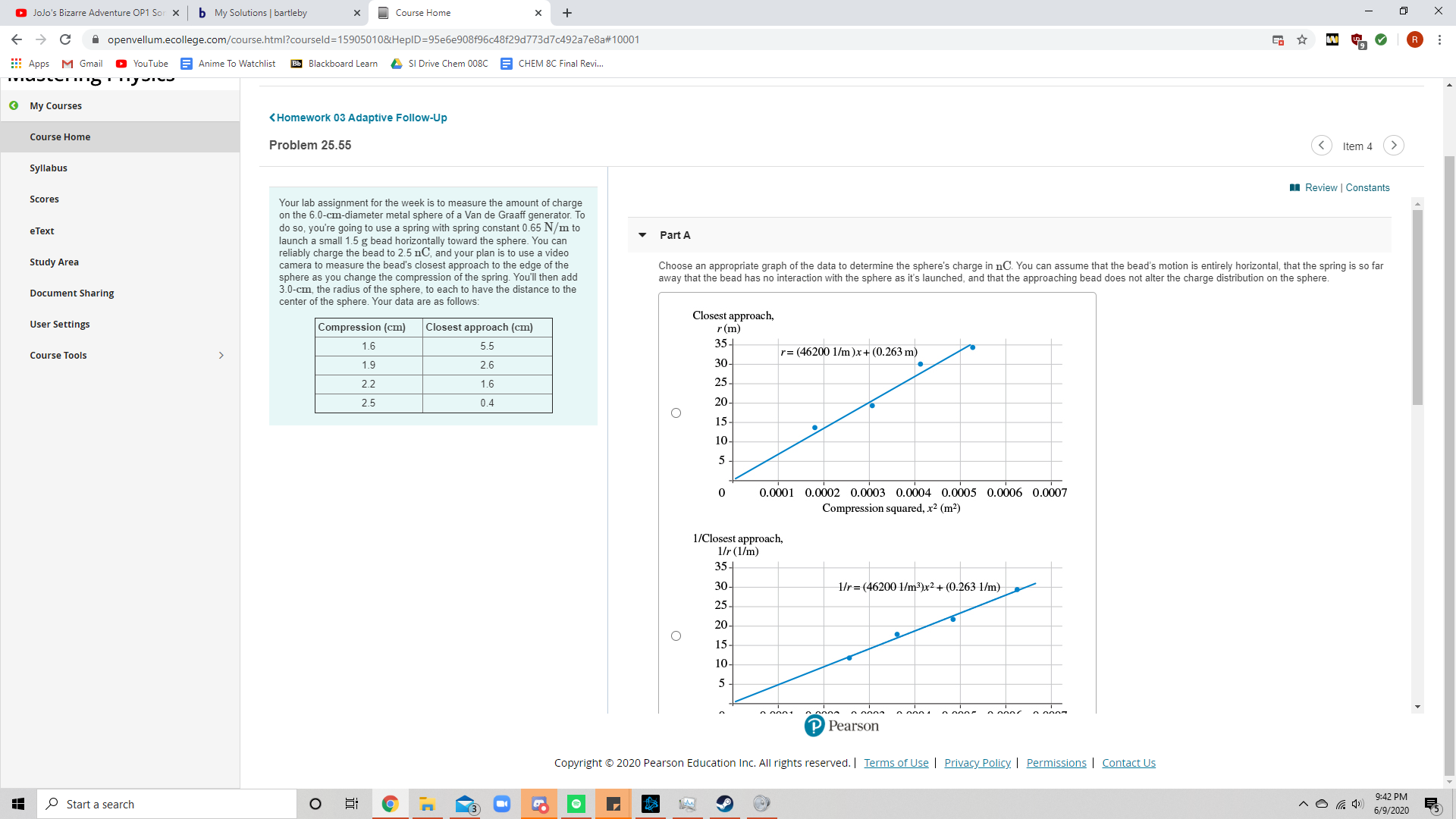Your lab assignment for the week is to measure the amount of charge on the 6.0-cm-diameter metal sphere of a Van de Graaff generator. To do so, you're going to use a spring with spring constant 0.65 N/m to launch a small 1.5 g bead horizontally toward the sphere. You can reliably charge the bead to 2.5 nC, and your plan is to use a video camera to measure the bead's closest approach to the edge of the sphere as you change the compression of the spring. You'll then add 3.0-cm, the radius of the sphere, to each to have the distance to the center of the sphere. Your data are as follows: Part A Choose an appropriate graph of the data to determine the sphere's charge in nC. You can assume that the bead's motion is entirely horizontal, that the spring is so far away that the bead has no interaction with the sphere as it's launched, and that the approaching bead does not alter the charge distribution on the sphere. Closest approach, r(m) 354 Compression (cm) Closest approach (cm) 1.6 5.5 r= (46200 1/m )x+ (0.263 m) 1.9 2.6 30 2.2 1.6 25. 2.5 0.4 20- 15- 10- 5 0.0001 0.0002 0.0003 0.0004 0.0005 0.0006 0.0007 Compression squared, x² (m²) 1/Closest approach, 1/r (1/m) 354 30- 1/r= (46200 1/m³)x² + (0.263 1/m) 25- 20- 15- 10- 5 0000 P Pearson
Your lab assignment for the week is to measure the amount of charge on the 6.0-cm-diameter metal sphere of a Van de Graaff generator. To do so, you're going to use a spring with spring constant 0.65 N/m to launch a small 1.5 g bead horizontally toward the sphere. You can reliably charge the bead to 2.5 nC, and your plan is to use a video camera to measure the bead's closest approach to the edge of the sphere as you change the compression of the spring. You'll then add 3.0-cm, the radius of the sphere, to each to have the distance to the center of the sphere. Your data are as follows: Part A Choose an appropriate graph of the data to determine the sphere's charge in nC. You can assume that the bead's motion is entirely horizontal, that the spring is so far away that the bead has no interaction with the sphere as it's launched, and that the approaching bead does not alter the charge distribution on the sphere. Closest approach, r(m) 354 Compression (cm) Closest approach (cm) 1.6 5.5 r= (46200 1/m )x+ (0.263 m) 1.9 2.6 30 2.2 1.6 25. 2.5 0.4 20- 15- 10- 5 0.0001 0.0002 0.0003 0.0004 0.0005 0.0006 0.0007 Compression squared, x² (m²) 1/Closest approach, 1/r (1/m) 354 30- 1/r= (46200 1/m³)x² + (0.263 1/m) 25- 20- 15- 10- 5 0000 P Pearson
Physics for Scientists and Engineers, Technology Update (No access codes included)
9th Edition
ISBN:9781305116399
Author:Raymond A. Serway, John W. Jewett
Publisher:Raymond A. Serway, John W. Jewett
Chapter25: Electric Potential
Section: Chapter Questions
Problem 25.52P: Lightning can be studied with a Van de Graaff generator, which consists of a spherical dome on which...
Related questions
Question
How do I do these problems?


Transcribed Image Text:Your lab assignment for the week is to measure the amount of charge
on the 6.0-cm-diameter metal sphere of a Van de Graaff generator. To
do so, you're going to use a spring with spring constant 0.65 N/m to
launch a small 1.5 g bead horizontally toward the sphere. You can
reliably charge the bead to 2.5 nC, and your plan is to use a video
camera to measure the bead's closest approach to the edge of the
sphere as you change the compression of the spring. You'll then add
3.0-cm, the radius of the sphere, to each to have the distance to the
center of the sphere. Your data are as follows:
Part A
Choose an appropriate graph of the data to determine the sphere's charge in nC. You can assume that the bead's motion is entirely horizontal, that the spring is so far
away that the bead has no interaction with the sphere as it's launched, and that the approaching bead does not alter the charge distribution on the sphere.
Closest approach,
r(m)
354
Compression (cm)
Closest approach (cm)
1.6
5.5
r= (46200 1/m )x+ (0.263 m)
1.9
2.6
30
2.2
1.6
25.
2.5
0.4
20-
15-
10-
5
0.0001 0.0002 0.0003 0.0004 0.0005 0.0006 0.0007
Compression squared, x² (m²)
1/Closest approach,
1/r (1/m)
354
30-
1/r= (46200 1/m³)x² + (0.263 1/m)
25-
20-
15-
10-
5
0000
P Pearson
Expert Solution
This question has been solved!
Explore an expertly crafted, step-by-step solution for a thorough understanding of key concepts.
This is a popular solution!
Trending now
This is a popular solution!
Step by step
Solved in 3 steps with 3 images

Knowledge Booster
Learn more about
Need a deep-dive on the concept behind this application? Look no further. Learn more about this topic, physics and related others by exploring similar questions and additional content below.Recommended textbooks for you

Physics for Scientists and Engineers, Technology …
Physics
ISBN:
9781305116399
Author:
Raymond A. Serway, John W. Jewett
Publisher:
Cengage Learning

Principles of Physics: A Calculus-Based Text
Physics
ISBN:
9781133104261
Author:
Raymond A. Serway, John W. Jewett
Publisher:
Cengage Learning


Physics for Scientists and Engineers, Technology …
Physics
ISBN:
9781305116399
Author:
Raymond A. Serway, John W. Jewett
Publisher:
Cengage Learning

Principles of Physics: A Calculus-Based Text
Physics
ISBN:
9781133104261
Author:
Raymond A. Serway, John W. Jewett
Publisher:
Cengage Learning


College Physics
Physics
ISBN:
9781285737027
Author:
Raymond A. Serway, Chris Vuille
Publisher:
Cengage Learning

College Physics
Physics
ISBN:
9781938168000
Author:
Paul Peter Urone, Roger Hinrichs
Publisher:
OpenStax College

Physics for Scientists and Engineers: Foundations…
Physics
ISBN:
9781133939146
Author:
Katz, Debora M.
Publisher:
Cengage Learning